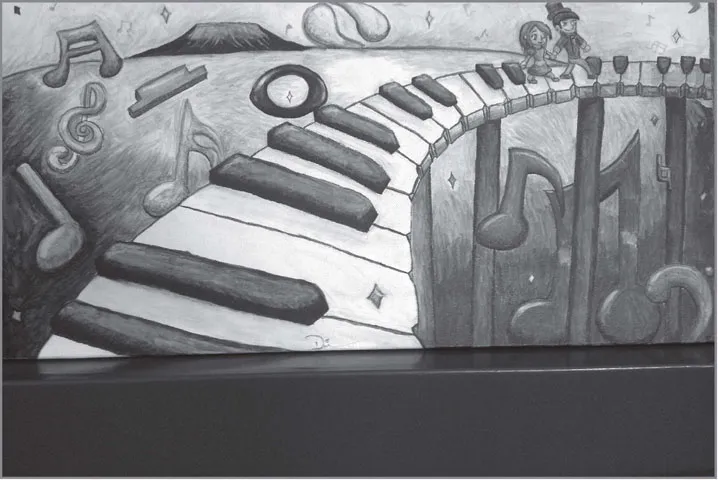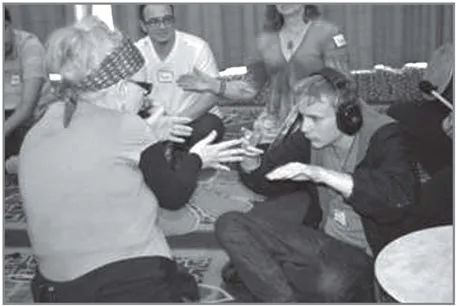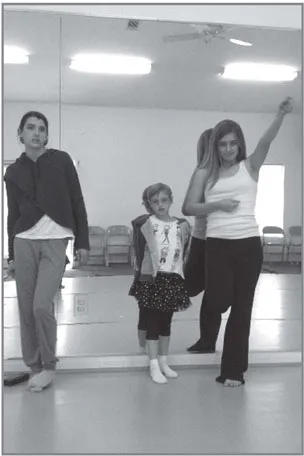![]()
PART I
UNDERSTANDING AUTISM MOVEMENT THERAPY®
![]()
CHAPTER 1
The Benefits of a Movement and Music Program
Art by Dani Bowman
“When we move we coordinate our brain. Autism Movement Therapy® helped me coordinate my body too. When I was younger, I thought it would just be free dance, but I like that we have a routine basically.”
EMMA ELIZABETH BATHUM, 14 YEARS OLD
Movement and music makes a profound impact on individuals with autism. One of the most exciting discoveries we’ve made in the 40 plus years of our individual and collective work in autism is how art expression, including movement and dance, profoundly impacts people with autism. Young and old, boys and girls, men and women, verbal and non-verbal—we’ve watched how participation in the arts improves and builds essential skills in many areas of autism’s core deficits of speech and language, social skills and behavioral challenges.
The expressive arts give rise to communication for the voiceless, meaning to the intangible and comprehension to the mysteries of human interactions. Participation in movement and music provides a literal and metaphoric stage upon which to share the inner being of our souls. Yet movement and music gives opportunities for much more. As the economy dwindles, and the demand for intensive, viable therapies in autism rises, the need for affordable—low cost or free—interventions became imperative. Can you imagine a simple, accessible program in movement and music that could meet many of those needs? Can you imagine having fun while growing and learning in autism?
Science is finally beginning to study the effects of the expressive arts on autism—and it’s about time. Steven Kapp, an autism researcher at the University of California, Los Angeles tells us, “Now that the autism field has begun to intensively study sensory-movement differences, they have become better understood, with potential to spur change” (Kapp 2013). Research is beginning to support what we’ve discovered through Autism Movement Therapy (AMT) and other art forms for decades; that an early intervention program that includes the expressive arts is fundamentally productive and the outcomes can (and do) drastically benefit the child’s needs. The arts provide powerful, results-based strategies for autistic individuals through solid, well-conceived and structured programs such as AMT that literally wake up the brain! We invite you to come along with us on this journey of exploration and possibilities to see for yourself the rewards in store for you, your child, your students and your clients.
MOVEMENT AND MUSIC HELPS DEVELOP ESSENTIAL CORE SKILLS
In addition to simple, fun exercise and social interaction, AMT helps to develop essential skills and positively affects autism’s challenges, including:
•speech, language and communication
•gross and fine motor skills/planning
•proprioception, balance and spatial orientation
•sensory processing and integration
•social and life skills
•physical health and wellness
•self-esteem, self-awareness and self-determination
•anxiety and depression.
Keri with Neal AMT class
With hundreds of anecdotal, real-life stories of how AMT has benefited the autistic kids and adults we’ve worked with, it’s a simple brush stroke to share how, for example, 20-year-old student, Neal, willingly relinquished his headphones to “tolerate” the music and boisterous interactions of an afternoon session at a week-long AMT spring class. The immediate benefits to Neal were apparent. Neal’s sensory integration issues (sound), social and spatial awareness (proximity to others in a group), and communication skills (improved ability to convey his needs during our sessions) increased. The pleasurable and fluid nature of AMT movement and music, by its nature, puts kids at ease, relaxing their minds and bodies. Neal is one example of this. We will reveal why this occurs in coming chapters.
“Joanne’s class helped make my balance better. I feel good about that.”
EMMA, AGED 13
Emma, aged 10, is in the center
It is typical for children like Emma to start out in AMT classes with behavioral challenges, anxiety and body balance/coordination deficits. At eight years old, Emma was unsure—or unaware—of where her body was situated in relationship to the environment and people around her (poor body-to-environment challenge). In class, she was significantly challenged by the movements and routines of AMT. Carol Kranowitz tells us in her book The Out-of-Sync Child that oftentimes perceptual motor therapy, or integrated movement experiences that remediate gross-motor, fine-motor and visual discrimination problems, stimulate alternative routes to the memory and sequencing for children who do not respond to the methods taught in the conventional classroom (2005, p.224).
For years, Emma had participated in intensive occupational therapy (OT). OT had helped with many of her challenges, but in this new environment, Emma was unable to move her body as a unit through space in the class. Whether attempting to imitate the instructions of “arms in the air,” “feet apart,” “feet together,” or just execute simple slides across the room, Emma struggled to move her body parts in unison. Her head, like many kids with autism, preceded her body as she crossed the floor, her legs behind her. Her brain was not wired (yet) to send the proper and necessary signals to her body for her to follow the routines. Note: We say “yet,” because the very idea of changing or altering brain connectivity after a certain age remains controversial amongst experts. But we believe in the concept of neuroplasticity, as we will discuss in Chapter 2, which supports the idea that the brain can indeed form new connections that improve both physical and mental abilities.
The initial expectations for Emma when she began taking the AMT class in the winter of 2008 were two-fold: a) to help her to become comfortable in the environment; and b) to introduce her to the AMT movement patterns and sequences. She also needed time to adjust to yet another new and unfamiliar teacher in her life. After several weeks, and as Emma’s trust in the environment grew, she began to bond with her class peers and become more comfortable in her new surroundings. It was exciting to see whole body movements begin to emerge. Over time, Emma developed more confidence and enjoyment in the sessions. She did not become comfortable with becoming a leader for at least a year…but with us wanting all kids to be leaders, it happened. Not all children are ready in the beginning, but all of them flourish when they become leader. They let us know when they are ready.
SAY “CHEESE!”
Looking at old film footage of Emma is one way we can see her improvement over time. It is useful to use video and film to document dance, drama, music and art sessions; that way, you can create a realistic visual and auditory baseline of the child’s present level of performance, and then, over time, you and the parents can document growth and development just like you would in a classroom setting. The parents appreciate this as well. “Seeing” is generally better than “telling,” and “asking” always trumps telling. When we ask, we stimulate the higher-level thinking skills thereby “waking up the brain.” Case in point, if you “tell your student to go put his backpack away in the cubby,” you have not required the brain to do any “work,” but if you ask, “where do you need to put your backpack?” then you have asked the brain to engage. To formulate a question requires a thought process for an answer. This very act of the student thinking “where do I need to put my backpack?” activates lobes in the brain and stimulates neurons.
Videotaping a child is also a highly useful and effective tool to use in helping a child to “see” themselves. When they see how they present themselves to the world; what their body, their movements and facial expressions look like, new discussions and learning can unfold. Keri used to film and photograph her son, Taylor, when he was a young boy. Taylor is now 27 years old and lives independently through state and federal funding in a small town in southern California. From the time he was one year old and couldn’t crawl or talk, Keri would show him video footage or photographs and ask: “What does Taylor see?” or “Is Taylor happy or sad?” Because he could not speak outside of unintelligible babbles—it would be years before he would speak—she would talk to him as if he understood her. Keri’s intuition and her heart told her he would understand her words if she acted as if he could. This is what we mean by raising the bar.
Keri would add opinions to her questions such as, “It looks to me like Taylor feels sad. Is Taylor sad?” Then she would frown to help model the expression of “sad.” Over time, in the years and language that ultimately followed, Taylor emerged as reasonably sensitive to the emotions and feelings of self and others. He was self-aware, and able to look outside of his previously isolated world. Was this an accident or simply normal development? Considering autism, I don’t think so. It was hard work, creativity and dedication that brought this inward, isolat...



